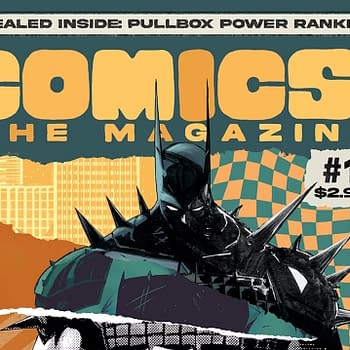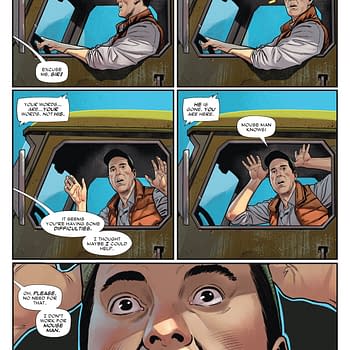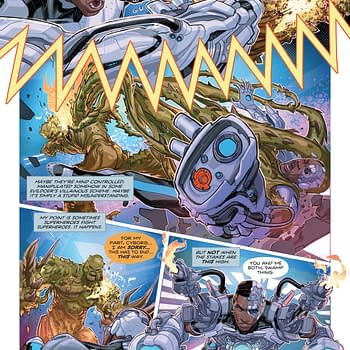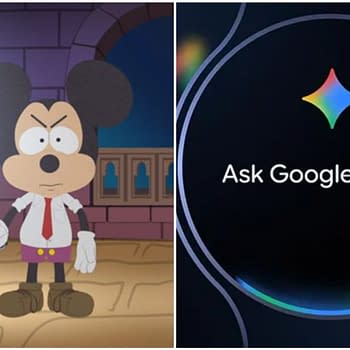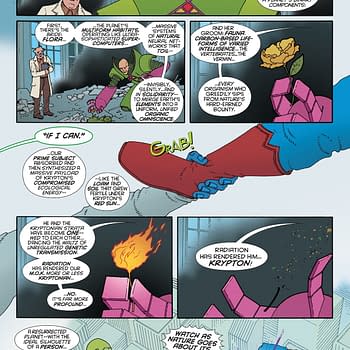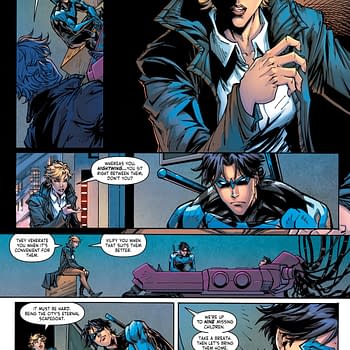Posted in: Comics | Tagged: comic scripting, Comics, entertainment, Gotham Central, greg rucka
From Strip To Script – Gotham Central #2
By Josh Hechinger
Welcome to From Strip to Script, where I take a page of finished comic art and try to derive a script from it, to see what I can learn from the exercise.
Okay, look…I'm going to pull you aside, conspiratorially, for a second.
All clear? Just us? Okay.
I have mixed feelings about "filmic comics".
"What are filmic comics?" you ask (presumably after I've somehow managed to shush away the "who are you?" and "why are you buttonholing me about comics?" questions)?
I'm glad you asked: filmic comics, for the purposes of this piece, are those comics which seem to explicitly ape or graft the techniques of filmed media onto the medium of sequential art. On the "ugh" end of the spectrum, you have comics which are explicitly storyboards or roundabout pitches for a movie. On the other end of the spectrum, you have comics that successfully translate distinct cadences of filmed media into a static-yet-sequential print medium.
I didn't name names (or title titles?) for either example, because…well, there's where the aforementioned mixed feelings come in: what I consider successful on the high end of the spectrum might not jibe with someone else as a reader, and what I consider the low end of the spectrum might be someone's genuine passion project.
That said, the comic we're gonna look at is one I consider to be on the high end of that spectrum: Gotham Central, which successfully maps the procedural nature of modern cops shows to the "justice is a tug of war between a millionaire ninja dressed kind of like a bat and an immortal murder clown" nature of crime in Gotham City.
We're looking at page six of issue two by Ed Brubaker and Greg Rucka (writers), Nachie Castro (assistant editor), Digital Chameleon (separations), Noelle Giddings (colors), Matt Idelson (editor), and Willie Schubert (lettering).
PAGE SIX (SIX PANELS)
P1. Inset. Outside the department.
– SAWYER –Listen up, people!
P2. SAWYER'S striking a Superman pose (chest out, hands on hips…most importantly: pulling it off…kinda? It's Gotham, after all) while MONTOYA addresses the room of detectives in front of the blackboard they're using to track the case (we can see FREEZE written on it).
– SAWYER Detective Montoya?
– MONTOYA Okay…to make sure everyone's on the same page I'm going to hit these points again in brief.
– MONTOYA At approx oh-six this morning detectives Fields and Driver went to question some men at the Wharfside Inn on a tip in connection with the Lewis kidnapping.
– MONTOYA At the hotel they encountered Victor Fries with an unidentified associate known only as "Danny".
– MONTOYA Fries subdued both detectives, then murdered Detective Fields. Sometime in the next few hours he also apparently killed Danny…
P3. MONTOYA scans the room.
– MONTOYA And now you know everything we do.
– MONTOYA Detective Azeveda?
P4. AZEVEDA is raising his pen.
– AZEVEDA Any chance Freeze is connected to the Lewis grab?
P5. MONTOYA spreads her hands. SAWYER keeps her chin up.
– MONTOYA No…it was just rotten %$&^ing luck, Josh.
– SAWYER The Lewis kidnapping has been handed to the F.B.I. for the time being…
P6. SAWYER'S mouth tightens into a hard little line.
– SAWYER …Detective Fields' murder is our only priority right now.
So, What'd We Learn?
The reason I was having a ramble about "filmic comics" up top is that this page is more or less straight out of one of those procedural cop shows on the tee vee; on the surface, there's nothing especially "comicky" about it.
And yet.
Those first two panels in particular are an example of how comics and film fundamentally differ in terms of how they handle visual space and narrative moments in time.
Like, okay, we've got the establishing shot of the police department in P1, right? Just as a little inset panel, whereas a television show or movie would have to, by definition, have that eat up the entire frame and whatever moments in time the camera has to dedicate to it. Whereas in a comic, doing it as a little inset panel makes the change in location register with the reader, but doesn't necessarily arrest the forward momentum of the story.
Then in the next panel, having all the narrative pipe that Montoya lays as a large, single panel simultaneously compresses the moment, but lets the information within breathe a bit, if that makes sense? It's a recap of information we already know, basically the events of the first issue. Keeping that all contained to a single big panel allows the reader to peruse it at their leisure, but it also means you can "skip" that panel, consciously or subconsciously, on re-reads.
Philly-based comic writer Josh Hechinger [joshhechinger.tumblr.com] is a Cancer, and his blood type is A+. You can find him being a loquacious dope on Twitter, and read his comic collaborations on Comixology.











